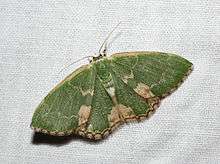Comibaena
Comibaena is a genus of moths in the family Geometridae. It was described by Jacob Hübner in 1823.
| Comibaena | |
|---|---|
 | |
| Comibaena bajularia | |
| Scientific classification | |
| Kingdom: | Animalia |
| Phylum: | Arthropoda |
| Class: | Insecta |
| Order: | Lepidoptera |
| Family: | Geometridae |
| Subfamily: | Geometrinae |
| Tribe: | Comibaenini |
| Genus: | Comibaena Hübner, [1823] |
| Synonyms | |
| |
Description
It differs from Agathia in the antennae being bipectinated (comb like on both sides) to three-fourths length in both sexes. The hind tibia of the male is not dilated. Hindwings with veins 6 and 7 stalked.[1]
Species
- Comibaena albimarginata (Warren, 1893)
- Comibaena amoenaria (Oberthür, 1880)
- Comibaena argentataria Leech, 1897
- Comibaena attenuata (Warren, 1896)
- Comibaena bajularia (Denis & Schiffermüller, 1775) – blotched emerald
- Comibaena biplaga Walker, 1861
- Comibaena cassidara (Guenée, 1857)
- Comibaena cheramota Meyrick
- Comibaena connata (Warren, 1898)
- Comibaena delicatior (Warren, 1897)
- Comibaena diluta (Warren, 1895)
- Comibaena falcipennis (Yazaki, 1991)
- Comibaena fuscidorsata Prout, 1912
- Comibaena leucochloraria (Mabille, 1880)
- Comibaena leucospilata Walker
- Comibaena longipennis Warren
- Comibaena mariae (Lucas, 1888)
- Comibaena meyricki Prout
- Comibaena pictipennis Bulter, 1880
- Comibaena procumbaria (Pryer, 1877)
- Comibaena pseudoneriaria Wehrli, 1926
- Comibaena punctaria (Swinhoe, 1904)
- Comibaena quadrinotata Butler, 1889
- Comibaena rhodolopha Prout, 1915
- Comibaena serrulata D. S. Fletcher, 1963
- Comibaena subdelicata Inoue, 1985
- Comibaena takasago Okana, 1960
- Comibaena tancrei Graeser, 1889
- Comibaena tenuisaria (Graeser, 1888)
gollark: Regardless of what choice you make, the contents of the boxes are fixed, thus pick mildly more money. This probably sounds unsmart to you, which is either because you (and the server generally) are/is right, or because you fell into one side and now think it's obvious.
gollark: As I said, in general apparently both sides are split pretty evenly, have fairly convincing arguments each way, and both think that their answer is obvious and the other is wrong.
gollark: Perhaps we are HIGHLY smart unlike random internet people and OBVIOUSLY picked the correct® answer, or perhaps we just hold similar philosophical/intellectual/whatever views which make us more inclined to one-box.
gollark: I mean, maybe the average internet rabble is just bad at understanding what "perfect prediction" means, but you could probably argue that it's "rational" at the time of choosing to take both, even if it's... acausally...? worse for you. Nobody here appears to have.
gollark: It's paradoxical because it breaks decision theories somewhat.
References
- Hampson, G. F. (1895). The Fauna of British India, Including Ceylon and Burma. Moths Volume III. Taylor and Francis – via Biodiversity Heritage Library.
- Savela, Markku. "Comibaena Hübner, [1823]". Lepidoptera and Some Other Life Forms. Retrieved March 26, 2018.
- Pitkin, Brian & Jenkins, Paul. "Search results Family: Geometridae". Butterflies and Moths of the World. Natural History Museum, London.
This article is issued from Wikipedia. The text is licensed under Creative Commons - Attribution - Sharealike. Additional terms may apply for the media files.